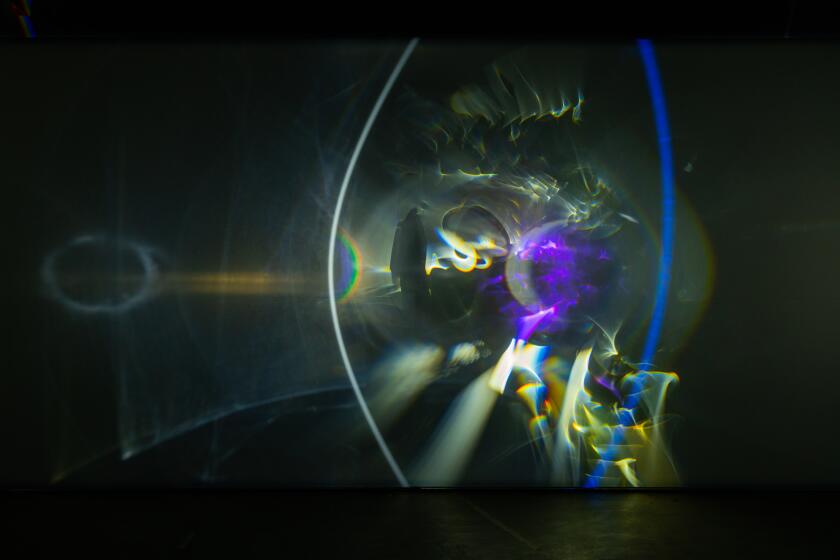Dreamy, disturbing, haunting images
The announcement for “Hyper-Graphics,” Austrian artist Arnulf Rainer’s show at the MAK Center, is one of the most striking to come across my desk in a long time: a glossy, fold-out poster bearing an image of the Schindler House, where the center is located -- actually a photograph of a photograph of the house -- bathed in warm, slightly queasy yellows and greens, with “A. Rainer” scrawled across the bottom in blood red.
It’s not a particularly flashy or elaborate piece, but it’s utterly engrossing: a masterfully nuanced study in contrasts achieved through the seemingly spontaneous arrangement of a few basic elements.
The house, seen from across a garden in a dreamy soft focus, recedes from the picture plane, while the letters leap forward, so violently rendered that they appear to gouge the surface of the paper (the photograph of the photograph), calling attention to the multiple layers. The building is a horizontal band of clean, perpendicular lines, solidly nestled in greenery, while the letters, though arranged in a parallel band of precisely the same scale, slant urgently to the right, as if straining to slip off the page.
It is a fitting introduction to a show devoted to Rainer’s poster designs. There are 26 on display, dating back to 1951, along with preparatory drawings and additional graphic works, including designs for book covers, catalogs and theatrical performances.
Like Robert Rauschenberg, whose posters were surveyed at LACMA in 2005, Rainer clearly views this work as an extension of his primary practice. The posters reflect themes and imagery at play throughout the artist’s career and brim with the same barely contained frenetic energy.
Many of the early works involve drawings made over photographic self-portraits in which Rainer violently contorts his face or body. Others involve news images, art historical reproductions or -- among the most disturbing -- photographs of corpses and cadavers. Among the most beautiful are recent works, such as the Schindler House poster, involving richly saturated color snapshots.
The drawings, rendered primarily in ink, graphite and crayon, are characterized by torrents of quick, vigorous lines and squiggles -- some light and almost playful, others so forceful that they do scar the surface of the paper. The application feels largely haphazard, but the effect can be devastating -- as in a series involving images of the city of Hiroshima, where the scribbling accumulates in dense, angry patches of black that suggest windows into the abyss.
MAK Center for Art and Architecture, 835 N. Kings Road, Los Angeles, (323) 651-1510, through Aug. 26. Closed Sundays through Tuesdays. www.makcenter.org.
Summer show: hot wheels
It must be nice to be Chris Burden. The Gagosian Gallery calls you, offers you its summer show. Maybe you’re lounging by the pool, maybe you’re tromping through the brush in Topanga. You think for a minute, then turn to your assistant: “Why don’t we just give ‘em a couple of the cars?”
Your assistant raises his eyebrows. Isn’t that too easy?
“Just park ‘em there in the gallery. We’ll take a few photographs, if they want something to sell -- hang those up. And don’t we have an old video kicking around somewhere?”
OK, that’s probably not how it happened, but that is, indeed, what the show consists of: two vehicles from Burden’s personal collection, parked on the gallery floor; a few big Polaroids depicting Burden and his assistant standing next to these vehicles; and a video, made in 2004, of another work, called “Metropolis.” The effect is that of a formidable artist at the height of his career reaching into his sock drawer for ideas.
The funny thing is, it kind of works. The show’s title is “Yin Yang,” and the two vehicles -- a 1973 Lotus Europa and a 1954 International T6 tractor -- illustrate the concept beautifully: one 1,500 pounds, fast, extremely fragile and totally impractical, the other 5,000 pounds, creepingly slow and all but indestructible.
The virtue of the display is its apparent lack of irony. The photographs are kind of goofy, but Burden’s affection for the vehicles, rooted in a professed admiration for engineering and industrial design, is infectious: They’re beautiful objects and share the space with a quiet, touching sort of dignity.
The video, screened in a small room just off the main space, presents another clever inversion: tiny, plastic Hot Wheels cars buzzing on a track that weaves around a slow-moving model monorail. It is a mesmerizing spectacle of mindless intensity. The blind determination of these hardy little cars, their dizzy rattle against the edges of each curve, the delicious sound of plastic scraping plastic, the thrilling precariousness of it all -- it’s enough to awaken the 9-year-old boy in anyone.
Gagosian Gallery, 456 N. Camden Drive, Beverly Hills, (310) 271-9400, through Aug. 10. Closed Sundays and Mondays. www.gagosian.com.
Artistry in altering photographs
Most critics write, it’s fair to presume, in hopes of stimulating a wider conversation. But the act can feel more like speaking to a two-way mirror. It’s rare that the conversation, if initiated, circles back to the critic.
Curators York Chang and Karyl Newman make a commendable effort to close that circuit with “Dear Mr. Saltz,” a stimulating group show conceived as a response to a 2004 article by Jerry Saltz, then writing for the Village Voice (and now with New York magazine). In the article, titled “The Richter Resolution,” Saltz complained of a glut of unoriginal photo-based painting and, “in defense of the staggeringly radical act of really looking,” proposed “a 48-month moratorium on the reproduction of photographs via overhead, opaque, or slide projectors in painting (this means tracing too).”
Inspired by the discussions this article apparently generated in their circles, Chang and Newman invited eight photo-based painters to mount a defense. Each contributes several works and a letter addressed to Saltz.
Few of the artists veer radically from the Warhol/Richter/Celmins paradigm that Saltz decries, but none appears to be blindly imitating.
Julie Brown-Smith, Ed Johnson, Greg Santos and Holly Williams-Brock reproduce photographic scenes directly, with an emphasis on the iconic nature of the imagery or on such surface qualities as glare and blur. Allison Cortson also paints from photographs but incorporates dust collected from the homes of her subjects, which creates a far different effect.
Chad Robertson overlays images taken from sequential frames of a video to create multidimensional studies of expression and gesture. Tyler Stallings makes hyper-realistic paintings of his own unsettlingly grotesque photographic collages. Douglas C. Bloom flirts with abstraction in landscapes, playing with flatness, shape and texture.
The letters, most of which are touchingly earnest, agree with Saltz on his one overarching argument: Unoriginal, mechanical, clone-ish painting is bad; original, engaged, passionate painting is good.
And if Saltz’s polemic was simply a plea for the kind of serious, honest, rigorous looking that feeds good painting, that is what these artists are doing -- they just happen to be looking at photographs.
Pharmaka, 101 W. 5th St., Los Angeles, (213) 689-7799, through June 30. Closed Sundays through Tuesdays. www.pharmaka-art.org.
History turned on its ear
Steve Turner Contemporary is inaugurating its new space on Wilshire Boulevard with a show of work that takes the unfashionable step of looking backward, lingering on events that history -- and the novelty-hungry media -- would prefer to forget.
The show, “Past Over,” brings together several generations of artists from different cities and strikes a fine balance between humor and gravity, artistic intelligence and political critique.
San Francisco sculptor Michael Arcega reproduces icons of Spanish colonialism using banal contemporary materials -- a cannon made from paper and beer cans; a suit of armor from manila folders; a cathedral from PVC plastic. Baltimore-based Zoe Charlton contributes a series of drawings of unsettlingly eroticized women; Brooklyn-based Marc Andre Robinson one large drawing depicting a massive pile of crosses.
Mary Kelly’s “Johannesburg” is an elegant, text-based work drawn from the final report of the South African Truth and Reconciliation Commission. Sam Durant’s wonderfully deadpan photographs depict pilgrim and Indian figures from the now-defunct Plymouth National Wax Museum in Plymouth, Mass.
Ken Gonzales-Day’s large-scale photos of California lynching trees have made the rounds in recent years but remain no less startling and powerful.
The jewel of the show is “The Golden Age,” a two-channel video by the performance collective My Barbarian involving three artists in sailor costumes leading a multiracial crowd in a Macarena-like dance routine to a spirited, R&B-styled; slave song. The spectacle is patently, almost embarrassingly, ridiculous, but so enthusiastic as to be utterly irresistible -- a shrewd reflection of our tendency as a culture to reduce complicated historical tragedies to catchy melodies and a few stylized steps.
Steve Turner Contemporary, 6026 Wilshire Blvd., L.A. (323) 931-3721, through June 30. Closed Sundays and Mondays. www.steveturnercontemporary.com.
More to Read
The biggest entertainment stories
Get our big stories about Hollywood, film, television, music, arts, culture and more right in your inbox as soon as they publish.
You may occasionally receive promotional content from the Los Angeles Times.










